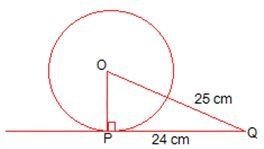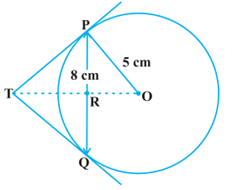| Class | 10 |
| Chapter | Circles |
| Subject | Math |
| Category | Important Question Answer |
Class 10 Math Chapter 10 Important Question Answer
Q1. The lengths of tangents drawn from an external point to a circle are ___________.
Ans. equal
Q2. A circle can have _______ parallel tangents at the most. Most Important
Ans. two
Q3. All circles are _________. (Similar/Congruent) Most Important
Ans. similar.
Q4. A tangent to a circle intersects it in __________ points. Most Important
Ans. one
Q5. A line intersecting a circle in two points is called ___________. Most Important
Ans. Secant
Q6. A tangent to a circle intersects it in _________ point(s).
Ans. one
Q7. The common point of a tangent to a circle and the circle is called __________. Most Important
Ans. point of contact
Q8. From a point Q, the length of tangent to a circle is 24 cm and distance of Q from centre is 25 cm. Find the radius of circle.
Ans.

Given, length of tangent PQ = 24 cm
OQ = 25 cm
Radius of Circle OP = ?
As we know, Tangent at any point on the circle is perpendicular to the radius through point of contact
Therefore, OT ⊥ PQ
In ∆ OPQ, Using Pythagoras theorem
OQ2 = OP2 + PQ2
252 = OP2 + 242
625 – 576 = 49 = OP2
OP = 7 cm
Therefore, length of radius of given circle is 7cm.
Q9. Find the length of tangent drawn from a point whose distance from the centre of a circle is 25 cm. Given the radius of circle is 7 cm.
Ans.

Given, Radius of circle OT = 7 cm
PO = 25 cm
PT = ?
As we know, Tangent at any point on the circle is perpendicular to the radius through point of contact
Therefore, PT ⊥ OT
In ∆ PTO, Using Pythagoras theorem
PO2 = TO2 + PT2
252 = 72 + PT2
625 – 49 = 576 = PT2
PT = 24 cm
Therefore, required length of tangent is 24 cm.
Q10. PQ is a chord of length 8 cm of a circle of radius 5 cm tangents at P and Q intersect at a point T. Find the length TP, if O is the centre of a circle.
Ans.

Join OT. Let it intersect PQ at the point R. Then ∆ TPQ is isosceles and TO is the angle bisector of ∠PTQ. So, OT⊥PQ and therefore, OT bisects PQ which gives PR = RQ = 4 cm.
Also, OR = = 3 cm
Now, ∠TPR + ∠RPO = 90° = ∠TPR + ∠PTR
So, ∠RPO = ∠PTR
Therefore, right triangle TRP is similar to the right triangle PRO by AA similarity.
This give, , i.e.,
or TP =
cm.
Note : TP can also be found by using pythagoras theorem.
Let TP = x and TR = y. Then
Using Pythagoras theorem,
x2 = y2 + 16 (Taking right ∆ PRT) —— (i)
x2 + 52 = (y + 3)2 (Taking right ∆ OPT) —– (ii)
Subtracting eq (i) from (ii), we get
25 = 6y – 7
y =
putting value of y in eq (i), we get
x2 =
x = cm
Q11. Prove that the tangents drawn at the ends of a diameter of a circle are parallel.
Ans.

Let us draw a circle with centre O and Diameter AB.
Let two tangents is drawn, one is PQ at point A and other is RS drawn at point B.
As we know,
OA ⊥ PQ (Tangent at any point on the circle is perpendicular to the radius through point of contact)
∠OAP = 90° —– (i)
Similarly, OB ⊥ RS (Tangent at any point on the circle is perpendicular to the radius through point of contact)
∠OBS = 90° —– (ii)
From eq (i) and (ii) we get,
∠OAP = ∠OBS = 90°
Since, AB is a transversal for lines PQ and RS and ∠BAP = ∠ABS
i.e. If alternate angles are equal then the line are parallel.
Therefore, PQ || RS.
Hence proved.
Q12. Prove that the length of tangents drawn from an external point to a circle are equal. Most Most Important
Ans.

We are given a circle with centre O, a point P lying outside the circle and two tangents PQ, PR on the circle from P.
We are required to prove that PQ = PR.
For this, we join OP, OQ and OR. Then ∠OQP and ∠ORP are right angles, because these are angle between the radii and tangents, and they are right angles as the tangent at any point of a circle is perpendicular to the radius through the point of contact.
Now in right triangles OQP and ORP,
OQ = OR (Radii of the same circle)
OP = OP (Common)
Therefore, OQP ≅ ORP (RHS)
This gives PQ = PR (CPCT)
Q13. Two tangents TP and TQ are drawn to a circle with centre O from an external point T. Prove that ∠PTQ = 2∠ OPQ.
Ans.

We are given a circle with centre O, an external point T and two tangents TP and TQ to the circle, where P, Q are the point of contact.
We need to prove that
∠PTQ = 2∠OPQ
Let ∠PTQ= θ
Now, TP = TQ as the lengths of tangents drawn from an external path to a circle are equal.
So, TPQ is an isosceles triangle.
Therefore, ∠TPQ = ∠TQP =
Also, ∠OPT = 90o as the tangent at any point of a circle is perpendicular to the radius through the point of contact.
So, ∠OPQ = ∠OPT – ∠TPQ = 90o –
=
This gives ∠PTQ = 2 ∠OPQ
Q14. Prove that in two concentric circles, the chord of the larger circle, which touches the smaller circle, is bisected at the point of contact.
Ans.

We are given two concentric circles, C1 and C2 with centre O and a chord AB of the larger circle C1 which touches the smaller circle C2 at the point P.
We need to prove that AP = BP.
Let us join OP.
Then, AB is a tangent to C2 at P and OP is its radius. Therefore, OP ⊥ AB
Now AB is a chord of the circle C1 and OP ⊥ AB. Therefore, OP is the bisector of the chord AB, as the perpendicular from the center bisects the chord,
i.e. AP = BP
Q15. Two concentric circles are of radii 5 cm and 3 cm. Find the length of the chord of the larger circle which touches the smaller circle.
Ans.

Given radius of bigger circle OP = 5 cm
Radius of smaller circle OA = 3 cm
Find PQ = ?
OA ⊥ PQ (because radius of circle is always perpendicular to its tangent)
Also, PA = AQ (because ∆ OAP ≅ ∆ OAQ)
In ∆ OAP, Using pythagoras theorem,
PO2 = PA2 + AO2
52 = PA2 + 42
9 = PA2
PA = 3
PQ = PA + AQ = 3 + 3 = 6cm
Q16. Prove that the tangents drawn at the ends of a chord of a circle make equal angles with the chord.
Ans. Given : Centre of circle O, PA and PB are tangents drawn at the ends A and B on chord AB.
Prove : ∠PAB = ∠ PBA
Proof : Join OA and OB.
OA = OB (Radii of the same circle)
∠OAB = ∠OBA (Angles opposite to equal sides) —– (i)
∠OAP = ∠OBP = 90 (As radius is always perpendicular to tangent)
∠OAB + ∠PAB = ∠OBA + ∠PBA — (ii)
Putting value of eq (i) in eq (ii) we get,
∠OAB + ∠PAB = ∠OAB + ∠PBA
∠PAB = ∠PBA
Hence proved.
| Also Read | Class 10 Math NCERT Solution |
| Also Read | Class 10 Important Questions [Latest] |